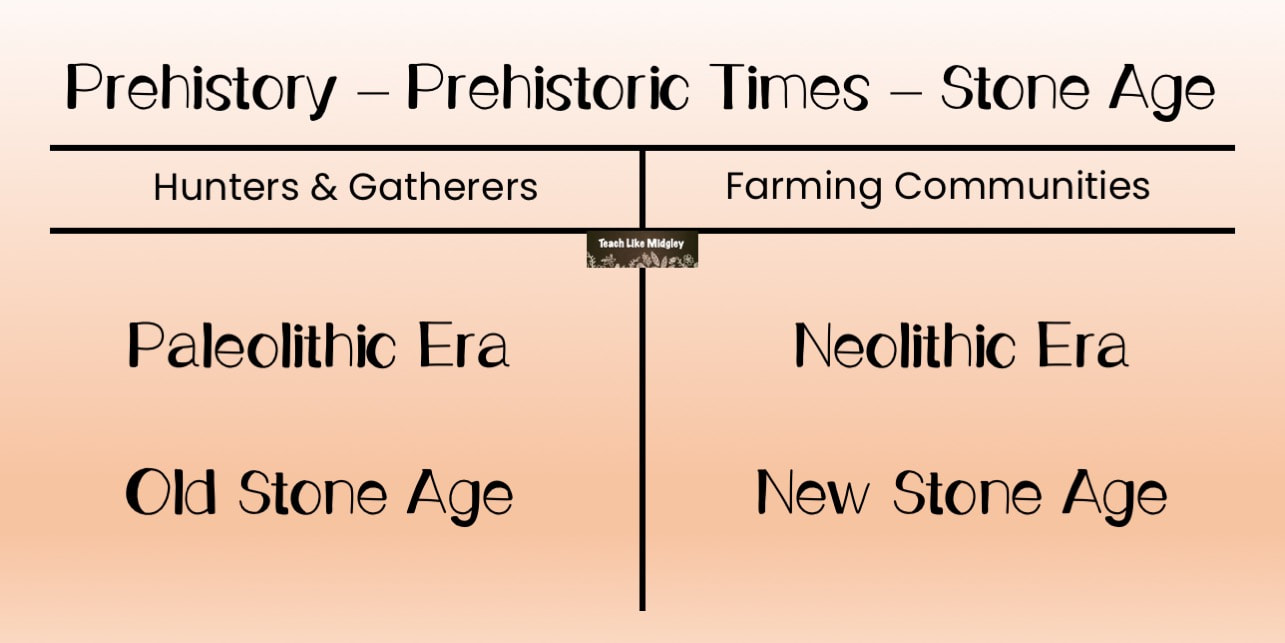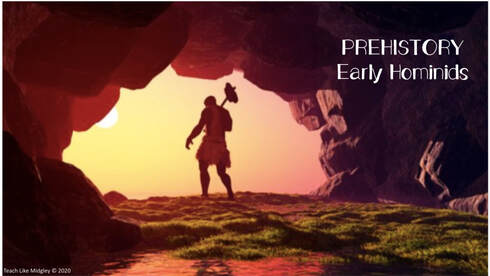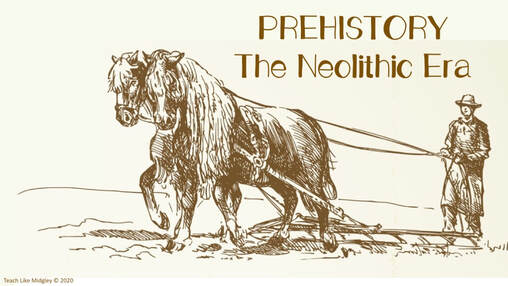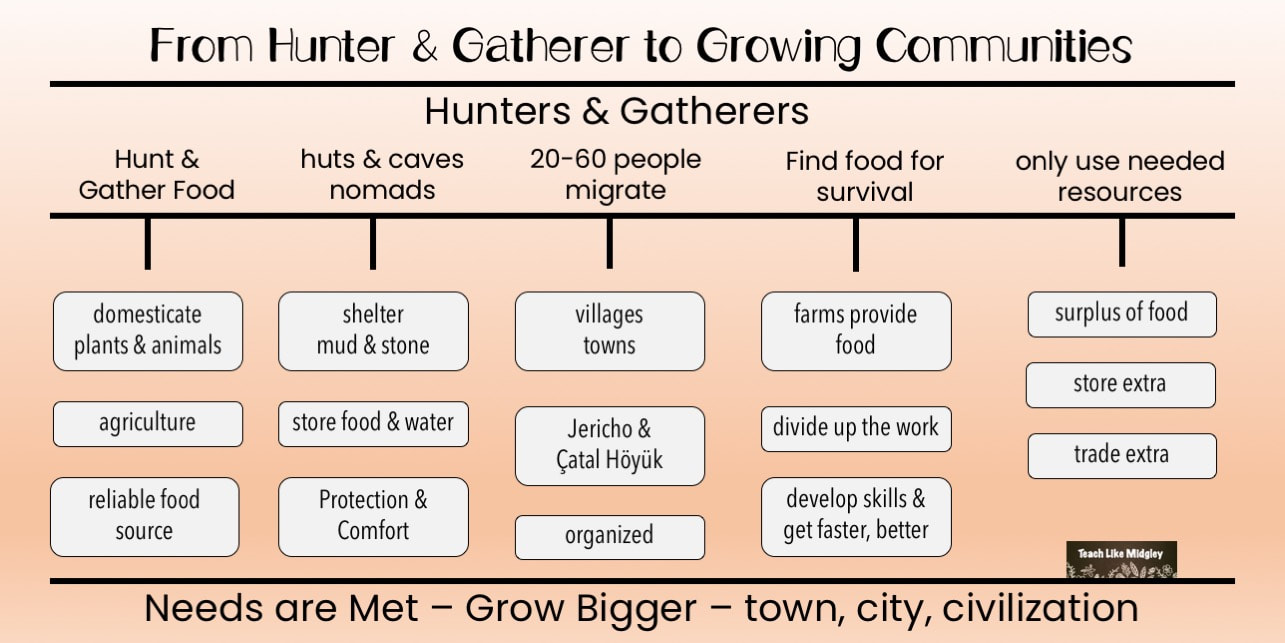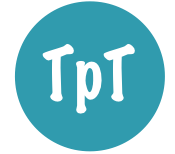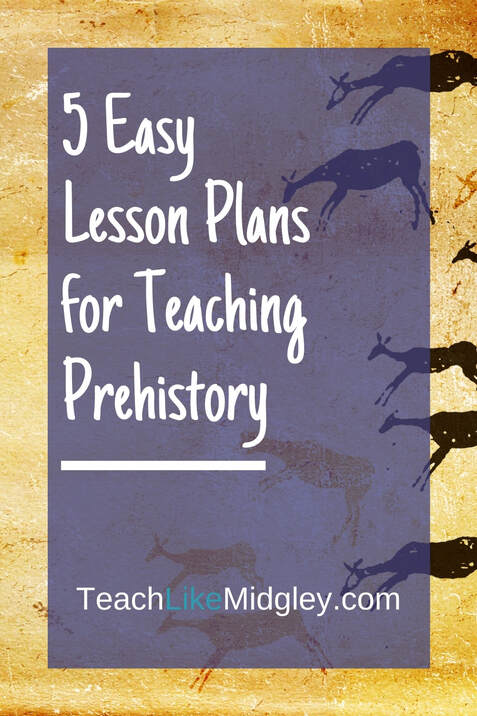5 Easy Lesson Plans for Prehistory
When you are handed a curriculum like ancient history, and you didn’t major in history while in college, it’s easy to feel overwhelmed and confused.
My first few years of teaching I had practically no guidance, curriculum, or resources to help me. It was a horrible, horrible feeling. And it is not a feeling I wish upon ANY teacher.
I remember when I left teaching at the private school and was hired to teach by the public school district. I was so excited to have a textbook! But my excitement quickly disappeared when I realized the organization of the text leaves a lot to be desired. I was closer to having structure, at least.
15 years of classroom experience has changed the way I look at curriculum. If I were to be handed a brand new curriculum today, that I knew nothing about, the first thing I would do is learn some key vocabulary and organize it.
My first few years of teaching I had practically no guidance, curriculum, or resources to help me. It was a horrible, horrible feeling. And it is not a feeling I wish upon ANY teacher.
I remember when I left teaching at the private school and was hired to teach by the public school district. I was so excited to have a textbook! But my excitement quickly disappeared when I realized the organization of the text leaves a lot to be desired. I was closer to having structure, at least.
15 years of classroom experience has changed the way I look at curriculum. If I were to be handed a brand new curriculum today, that I knew nothing about, the first thing I would do is learn some key vocabulary and organize it.
By organizing your content, you can simplify your curriculum and instruction.
Make no mistake – I am not “dumbing down” the content. I am simply organizing it in a way that makes it easier to teach and easier for students to learn.
Prehistory was one of the topics that confused me for too long. I would come across these titles and not know what to do with them or where to put my focus.
Imagine knowing nothing about this time period (maybe that is you exactly and why you are reading this) and coming across these names:
Prehistory
Paleolithic Era
Old Stone Age
Prehistoric Times
Neolithic Era
Stone Age
New Stone Age
Huh?
Exactly.
This list of 7 names all describe one time period that can be broken down into two sections.
Here is an easy organized chart to help clarify...
Phew. I hope that helps. See how a little organization can go a long way? It works for both teachers and students!
Now, in this post, I’m going to share with you 5 easy lesson plans that will ensure you are teaching the core concepts of prehistory.
Lesson #1 How Do We Learn About The Past?
Start by clarifying the difference between history and prehistory.
Then work your way into how we can learn about a time when there are no written records.
This leads you to key vocabulary like fossils, artifacts, and radio-carbon dating.
At this point, you are likely early in your school year. So I take the opportunity to teach students my expectations for using our notebook, completing vocabulary work, and navigating their textbook.
It’s also important to address why history can change. Experts study these artifacts and fossils and develop theories. These theories are what we read about in our books. But when new evidence is discovered, theories often change.
If you are interested in the materials I use to teach this lesson, check out my Prehistory: Learn About the Past Lesson Set
Then work your way into how we can learn about a time when there are no written records.
This leads you to key vocabulary like fossils, artifacts, and radio-carbon dating.
At this point, you are likely early in your school year. So I take the opportunity to teach students my expectations for using our notebook, completing vocabulary work, and navigating their textbook.
It’s also important to address why history can change. Experts study these artifacts and fossils and develop theories. These theories are what we read about in our books. But when new evidence is discovered, theories often change.
If you are interested in the materials I use to teach this lesson, check out my Prehistory: Learn About the Past Lesson Set
Lesson #2 Early Hominids
The evidence discovered by experts tell us there were hominids, or living beings with human-like characteristics, many years ago.
Many different classifications of hominids have been identified over the years. Focusing on the 5 major hominids is sufficient for 6th graders.
Australopithecus Afarensis
Homo Erectus
Homo Habilis
Homo Sapien Neanderthalensis
Homo Sapien Sapiens
Key concepts to focus on include: who first discovered them and where, when they lived, and what makes them unique.
Just looking at the scientific names is enough to make a kiddo throw their hands up in surrender. Using colors, motions, and nick names are fun ways to identify these hominids with 6th graders.
If you are interested in the materials I use to teach this lesson, check out my Prehistory: Early Hominids Lesson Set
Many different classifications of hominids have been identified over the years. Focusing on the 5 major hominids is sufficient for 6th graders.
Australopithecus Afarensis
Homo Erectus
Homo Habilis
Homo Sapien Neanderthalensis
Homo Sapien Sapiens
Key concepts to focus on include: who first discovered them and where, when they lived, and what makes them unique.
Just looking at the scientific names is enough to make a kiddo throw their hands up in surrender. Using colors, motions, and nick names are fun ways to identify these hominids with 6th graders.
If you are interested in the materials I use to teach this lesson, check out my Prehistory: Early Hominids Lesson Set
Lesson #3 The Paleolithic Era
The Paleolithic Era is all about early people who were just like us. The focus here, is that people spent the majority of their time on the move, hunting and gathering food. Since they lived as nomads, they only took what they could carry and the direction they traveled was based on following the food and weather patterns.
Life for early people was tough, they spent their entire lives in survival mode, searching for food and shelter from the elements.
One of the important aspects to cover, is that early people lived during an Ice Age, that created ice bridges which allowed people to migrate to different continents as they searched for food.
Another important aspect to discuss is how people learned to adapt to different environments in order to survive. Living in a forested area was very different from living in the plains.
If you are interested in the materials I use to teach this lesson, check out my Prehistory: Paleolithic Era Lesson Set
Life for early people was tough, they spent their entire lives in survival mode, searching for food and shelter from the elements.
One of the important aspects to cover, is that early people lived during an Ice Age, that created ice bridges which allowed people to migrate to different continents as they searched for food.
Another important aspect to discuss is how people learned to adapt to different environments in order to survive. Living in a forested area was very different from living in the plains.
If you are interested in the materials I use to teach this lesson, check out my Prehistory: Paleolithic Era Lesson Set
Lesson #4 The Neolithic Era
The Neolithic Era marks a big change for early people. Some experts argue it is one of mankind’s greatest achievements.
Learning how to grow crops and tame animals (also known as farming or the agricultural revolution) changed man’s way of life forever.
Although people continued to hunt (and still do to this day), farming allowed people to grow their own food supply. Which meant they started to establish permanent settlements for two reasons. First, they no longer needed to follow animal migrations for food, and second, they had to tend to their crops and livestock on a daily basis.
The ability to farm allowed people to create the first farming villages. Without a food supply, no other part of a society is possible. It was a great achievement.
If you are interested in the materials I use to teach this lesson, check out my Prehistory: Neolithic Era Lesson Set
Learning how to grow crops and tame animals (also known as farming or the agricultural revolution) changed man’s way of life forever.
Although people continued to hunt (and still do to this day), farming allowed people to grow their own food supply. Which meant they started to establish permanent settlements for two reasons. First, they no longer needed to follow animal migrations for food, and second, they had to tend to their crops and livestock on a daily basis.
The ability to farm allowed people to create the first farming villages. Without a food supply, no other part of a society is possible. It was a great achievement.
If you are interested in the materials I use to teach this lesson, check out my Prehistory: Neolithic Era Lesson Set
Lesson #5 The First Settlements
Finally, it is fitting that we end our unit of prehistory with the concept of how early farming villages grew and expanded.
Studying the earliest known settlements, Jericho and Catalhoyuk, are a great way to do this.
There are so many elements at play here, I find it’s fun to explore this growth by using a mind-map to see the progression.
If you are interested in the materials I use to teach this lesson, check out my Prehistory: First Settlements Lesson Set
Studying the earliest known settlements, Jericho and Catalhoyuk, are a great way to do this.
There are so many elements at play here, I find it’s fun to explore this growth by using a mind-map to see the progression.
If you are interested in the materials I use to teach this lesson, check out my Prehistory: First Settlements Lesson Set
Ready To Roll Materials
It’s important to note this post simply outlines the core concepts of an efficient prehistory unit. Some may argue there is need to put more emphasis in one place over another. I find that to be a personal preference.
The benefit of using this structure, is that you can confidently cover the core concepts for your students, while maintaining the flexibility to explore any of them on a deeper level. Teach all five lessons, but pick one of them where you do a project. Or teach all five lessons and do a culminating project at the end.
Now that you know what to teach, you might still be wondering how you should teach it. That’s where your crafty, teacher style comes in to play.
But sometimes you just don’t have time for that, and you need a done-for-you solution. And I’m happy to share that I can help you with that, too.
I’ve developed lesson sets for each of these 5 prehistory lessons. I wanted to provide done-for-you materials, but also still give you flexibility. Not every class of students has the same needs, and not every teacher has the same style they are comfortable with.
Each lesson set includes 8 pieces: a reading passage, a PowerPoint presentation, guided note-taking structure, notebook foldable, worksheet, activity, vocabulary study, 5 essential review questions, and links to relevant resources.
This lesson set design allows you to pick and choose which pieces will work best for you and your students.
Maybe you use the PowerPoint presentation and the guided notes to introduce the concepts to students. Then you have them complete the worksheet as an assignment.
Maybe you don’t want to do guided notes, but have students cut, glue, and complete the notebook foldable instead.
Maybe you have a student who missed the presentation so you provide them with the reading passage to complete their guided notes.
Maybe you want your students to dig a little deeper so you assign the activity to complete with partners.
And at the end, maybe you give the 5 questions as a quiz to assess their learning.
The possibilities go on! All these options for one lesson objective!
One lesson set = one lesson objective = 8 resources
Bonus: each of these resources come in Google slide formats too – Score!
If you snag the money saving bundle, you get all 5 of these lesson sets, plus a BONUS unit study packet.
That’s 5 lessons = 5 lesson objectives = 40 resources
Plus a unit study packet and all with Google slide formats. Ideal for navigating remote and hybrid learning.
The benefit of using this structure, is that you can confidently cover the core concepts for your students, while maintaining the flexibility to explore any of them on a deeper level. Teach all five lessons, but pick one of them where you do a project. Or teach all five lessons and do a culminating project at the end.
Now that you know what to teach, you might still be wondering how you should teach it. That’s where your crafty, teacher style comes in to play.
But sometimes you just don’t have time for that, and you need a done-for-you solution. And I’m happy to share that I can help you with that, too.
I’ve developed lesson sets for each of these 5 prehistory lessons. I wanted to provide done-for-you materials, but also still give you flexibility. Not every class of students has the same needs, and not every teacher has the same style they are comfortable with.
Each lesson set includes 8 pieces: a reading passage, a PowerPoint presentation, guided note-taking structure, notebook foldable, worksheet, activity, vocabulary study, 5 essential review questions, and links to relevant resources.
This lesson set design allows you to pick and choose which pieces will work best for you and your students.
Maybe you use the PowerPoint presentation and the guided notes to introduce the concepts to students. Then you have them complete the worksheet as an assignment.
Maybe you don’t want to do guided notes, but have students cut, glue, and complete the notebook foldable instead.
Maybe you have a student who missed the presentation so you provide them with the reading passage to complete their guided notes.
Maybe you want your students to dig a little deeper so you assign the activity to complete with partners.
And at the end, maybe you give the 5 questions as a quiz to assess their learning.
The possibilities go on! All these options for one lesson objective!
One lesson set = one lesson objective = 8 resources
Bonus: each of these resources come in Google slide formats too – Score!
If you snag the money saving bundle, you get all 5 of these lesson sets, plus a BONUS unit study packet.
That’s 5 lessons = 5 lesson objectives = 40 resources
Plus a unit study packet and all with Google slide formats. Ideal for navigating remote and hybrid learning.
Teach Skills
Whatever approach you choose, I encourage you to use your study of prehistory to also teach your students skills for success in your classroom. Expectations on note-taking, using the textbook, vocabulary study, working in partnerships, project management, etc. are all learning processes that will set your students up for finding success throughout the school year.
If you are interested in the materials I use to teach my prehistory unit, check out the money saving bundle: Prehistory: Lesson Set Bundle
If you are interested in the materials I use to teach my prehistory unit, check out the money saving bundle: Prehistory: Lesson Set Bundle
You May Also Like...
Let's Connect...

Welcome! I'm Hillary Midgley, a veteran 6th grade teacher.
I create educational materials and develop curriculum for other teachers. I specialize in teaching students how to learn through my Study Skills Curriculum. I have established fundamental classroom systems and structures for teachers to help them streamline their classroom. And my passion is teaching ancient history through engaging activities with foundations in academic skills. Here you will find resources on all of these topics and more. Learn more about me here.
|


